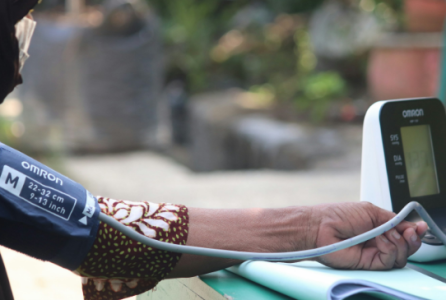Unlock the Secret to a Healthier Heart with This 5-minute Daily Exercise Trick!
By
- Replies 0
In a world where time is often cited as the biggest barrier to regular exercise, recent research brings hope for those of us who find our schedules packed to the brim. Just five minutes of exercise a day could be the key to lowering blood pressure and warding off heart problems. This revelation could change the game for many, especially our community members, who are always looking for efficient ways to stay healthy.
The study, which has caught the attention of health enthusiasts and busy bees alike, suggests that incorporating short bursts of exercise into your daily routine can have significant benefits for your heart health. This could be as simple as choosing to take the stairs instead of the elevator, going for a brisk cycle around the block, or even engaging in a vigorous household chore like scrubbing the floors.
Experts are now advocating for small but impactful lifestyle changes. Imagine swapping just five minutes of sedentary activities, such as watching television, for a quick run. This simple trade-off could substantially boost your cardiovascular health. The research indicates that activities that elevate the heart rate, including dancing, running, or even a spirited session of cleaning, offer the most substantial benefits.
The study's findings are based on an analysis of daily activities. On average, people spend around seven hours sleeping, ten hours sitting or engaging in other sedentary behaviours, three hours standing, one hour walking slowly, one hour walking quickly, and a mere 16 minutes in exercise that increases their heart rate, such as running or cycling.
By reallocating just five minutes of any of these activities to heart-rate-raising exercise, individuals saw a decrease in systolic blood pressure (SBP) by 0.68 millimetres of mercury (mmHg) and diastolic blood pressure (DBP) by 0.54 mmHg. To put this into perspective, systolic pressure is the top number in a blood pressure reading, indicating the pressure when the heart pumps blood out, while diastolic pressure is the bottom number, representing the heart at rest between beats.
At a population level, a reduction of 2mmHg in SBP and 1mmHg in DBP correlates with roughly a 10 per cent decrease in the risk of heart disease. According to the study published in the journal Circulation, achieving this could be as simple as dedicating 20-27 minutes of your day to exercise for SBP and 10-15 minutes for DBP.
For instance, to impact systolic blood pressure, one might consider replacing 21 minutes of sitting, 22 minutes of standing, or 26 minutes of slow walking with more vigorous exercise like cycling or jogging. For diastolic blood pressure, the benefits could come from swapping out 10 minutes of fast walking, 11 minutes of sitting, or 13 minutes of sleep for more intense physical activity.
High blood pressure is a leading cause of strokes and heart attacks, with millions of adults affected, many of whom are undiagnosed. Without proper management, high blood pressure can lead to an enlarged heart and, eventually, heart failure.
Dr Jo Blodgett, the lead author of the study from UCL, emphasises that exercise is crucial for reducing blood pressure, more so than less strenuous forms of movement such as walking. 'The good news is that, whatever your physical ability, it doesn’t take long to have a positive effect on blood pressure,' Dr. Blodgett says.
What's particularly encouraging about this study is that it recognises all forms of exercise-like activities, from climbing stairs to a short cycling errand, many of which can be seamlessly integrated into daily routines. For those who are less active, walking still offers some benefits for blood pressure, but for a more significant change, more demanding cardiovascular exercise is recommended.
So, dear members, it's time to embrace this 5-minute daily exercise trick and unlock the secret to a healthier heart. Whether it's a dance to your favourite tune, a quick pedal around the neighbourhood, or a vigorous tidy-up session, every little bit counts. Let's get our hearts pumping and our blood pressure down – it's never too late to start, and it's easier than you might think!
 We'd love to hear how you're incorporating these short bursts of exercise into your day. Share your experiences and tips in the comments below, and let's inspire each other to keep our hearts healthy and strong!
We'd love to hear how you're incorporating these short bursts of exercise into your day. Share your experiences and tips in the comments below, and let's inspire each other to keep our hearts healthy and strong!
The study, which has caught the attention of health enthusiasts and busy bees alike, suggests that incorporating short bursts of exercise into your daily routine can have significant benefits for your heart health. This could be as simple as choosing to take the stairs instead of the elevator, going for a brisk cycle around the block, or even engaging in a vigorous household chore like scrubbing the floors.
Experts are now advocating for small but impactful lifestyle changes. Imagine swapping just five minutes of sedentary activities, such as watching television, for a quick run. This simple trade-off could substantially boost your cardiovascular health. The research indicates that activities that elevate the heart rate, including dancing, running, or even a spirited session of cleaning, offer the most substantial benefits.
The study's findings are based on an analysis of daily activities. On average, people spend around seven hours sleeping, ten hours sitting or engaging in other sedentary behaviours, three hours standing, one hour walking slowly, one hour walking quickly, and a mere 16 minutes in exercise that increases their heart rate, such as running or cycling.
By reallocating just five minutes of any of these activities to heart-rate-raising exercise, individuals saw a decrease in systolic blood pressure (SBP) by 0.68 millimetres of mercury (mmHg) and diastolic blood pressure (DBP) by 0.54 mmHg. To put this into perspective, systolic pressure is the top number in a blood pressure reading, indicating the pressure when the heart pumps blood out, while diastolic pressure is the bottom number, representing the heart at rest between beats.
At a population level, a reduction of 2mmHg in SBP and 1mmHg in DBP correlates with roughly a 10 per cent decrease in the risk of heart disease. According to the study published in the journal Circulation, achieving this could be as simple as dedicating 20-27 minutes of your day to exercise for SBP and 10-15 minutes for DBP.
For instance, to impact systolic blood pressure, one might consider replacing 21 minutes of sitting, 22 minutes of standing, or 26 minutes of slow walking with more vigorous exercise like cycling or jogging. For diastolic blood pressure, the benefits could come from swapping out 10 minutes of fast walking, 11 minutes of sitting, or 13 minutes of sleep for more intense physical activity.
High blood pressure is a leading cause of strokes and heart attacks, with millions of adults affected, many of whom are undiagnosed. Without proper management, high blood pressure can lead to an enlarged heart and, eventually, heart failure.
Dr Jo Blodgett, the lead author of the study from UCL, emphasises that exercise is crucial for reducing blood pressure, more so than less strenuous forms of movement such as walking. 'The good news is that, whatever your physical ability, it doesn’t take long to have a positive effect on blood pressure,' Dr. Blodgett says.
What's particularly encouraging about this study is that it recognises all forms of exercise-like activities, from climbing stairs to a short cycling errand, many of which can be seamlessly integrated into daily routines. For those who are less active, walking still offers some benefits for blood pressure, but for a more significant change, more demanding cardiovascular exercise is recommended.
So, dear members, it's time to embrace this 5-minute daily exercise trick and unlock the secret to a healthier heart. Whether it's a dance to your favourite tune, a quick pedal around the neighbourhood, or a vigorous tidy-up session, every little bit counts. Let's get our hearts pumping and our blood pressure down – it's never too late to start, and it's easier than you might think!
Key Takeaways
- Just five minutes of daily exercise can lower blood pressure and reduce the risk of heart problems, according to recent research.
- Incorporating activities that elevate heart rate, like running, cycling, or even vigorous cleaning, can have significant cardiovascular benefits.
- Small lifestyle changes, such as opting for the stairs or a brief cycle instead of a sedentary activity, can make a difference.
- Reallocating just a few minutes of less active behaviours to more vigorous exercise can lead to a measurable decrease in both systolic and diastolic blood pressure, potentially reducing the risk of heart disease by around 10 per cent.








